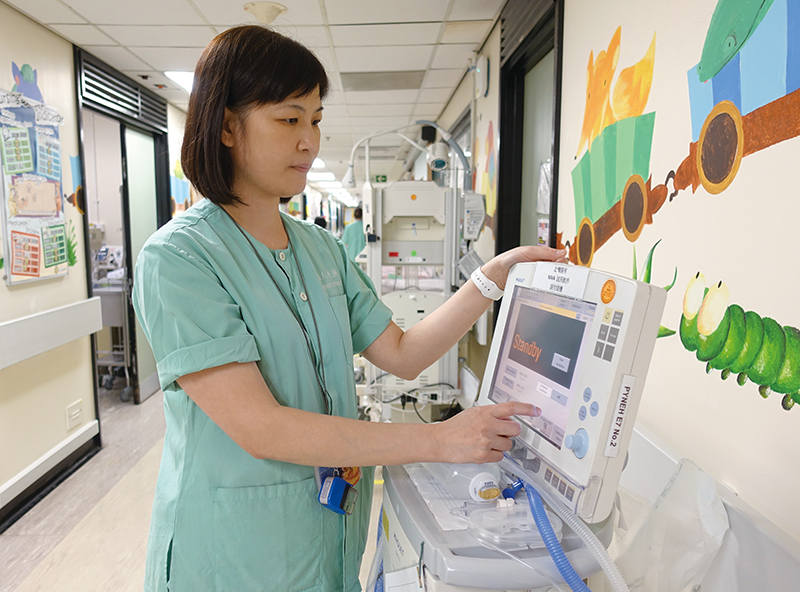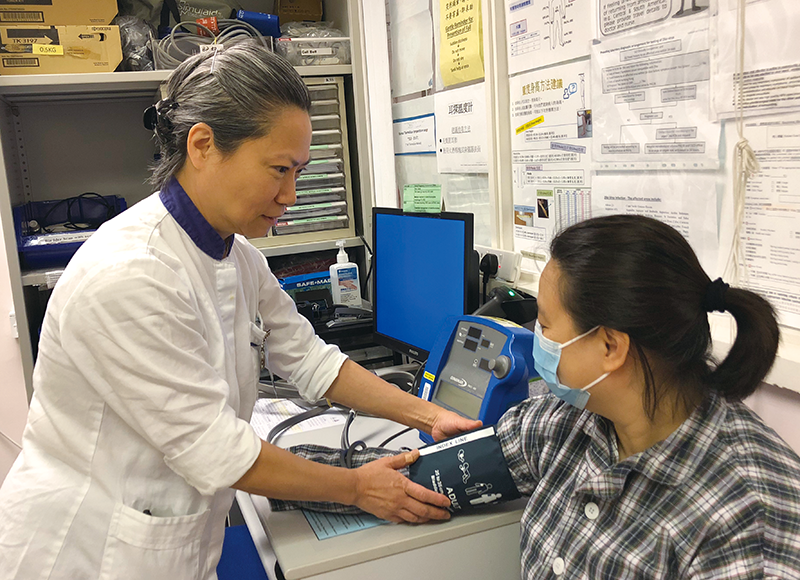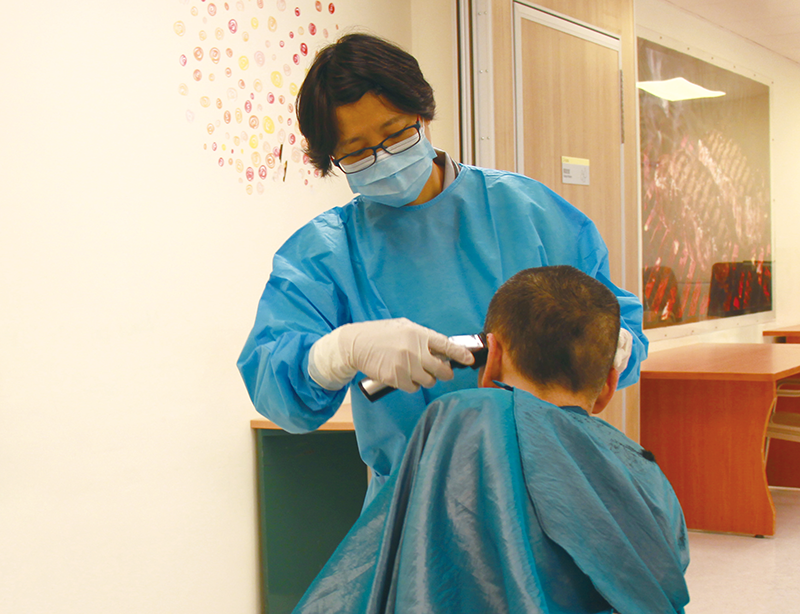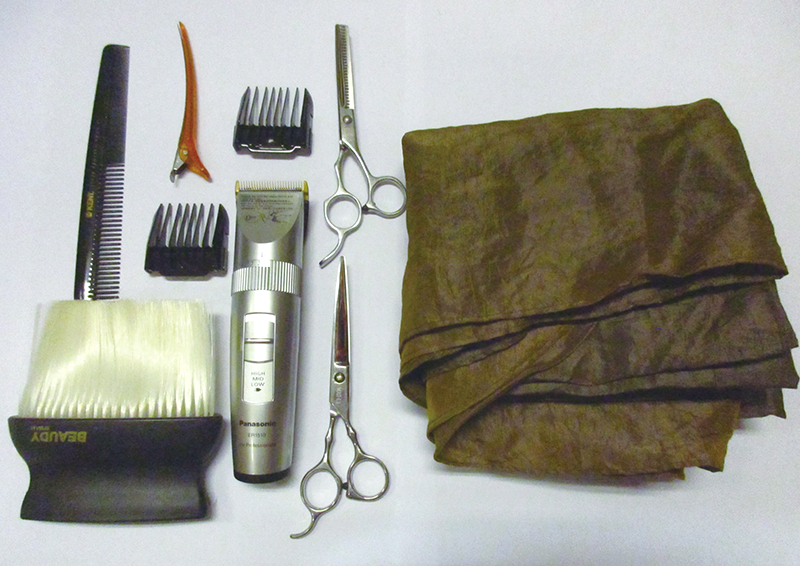Love and care behind-the-scene
Walking encyclopedia of medical instruments
Alice Chan
Patient Care Assistant II
Pamela Youde Nethersole Eastern Hospital
Alice Chan has mastered a wide range of medical instruments since joining public hospital services eight years ago from her previous job in a private clinic. After being trained by nurses, she joined the Paediatric Intensive Care Unit (PICU) and Paediatric Acute Ward and helped with patient admission, bed cleaning and disinfection, handling and operating medical instruments, and replacing tubes of mechanical ventilators for patients.
When Alice first arrived at the hospital, she knew nothing about medical instruments, nor did she know anything about ward operation. All she could do was job-shadowing and taking notes of what nurses taught her. Then she realised the best way to learn was to read through the operation manuals and, where necessary, seek advice from salespeople of various types of instrument to find out their function and operation as well as how to clean and disinfect them. “Most operation manuals are only available in English,” she says, “and I also come across many English medical terms at work and during communication with medical staff. I learn a lot by looking up new words in the dictionary.”
Nicknamed ‘captain’ in charge of medical instruments in PICU, Alice protects devices from clutter and wear and tear, and she even organises the wires and cables of the electrocardiogram machine with a DIY cable housing so that the machine operates more smoothly. Alice is well-liked by colleagues as she often helps others out of her initiative, especially when the ward is busy.
Caring beyond the call of duty
Au Yeung Wai-fan
Patient Care Assistant II
Queen Mary Hospital
Au Yeung Wai-fan’s role in looking after patients at gynaecology ward goes way beyond cleaning and feeding them. She also provides them with comfort and psychological support in times of need. On one occasion, she calmed down a patient who became emotional when her doctor wanted to call in a psychiatric team.
Another time, she accompanied a woman suffering excessive blood loss before delivering her child. Wai-fan comforted her, told her to be brave and not to be afraid until the woman was rushed to the operating theatre. The surgery was successful and Wai-fan later held hands and exchanged smiles with the woman when she returned to the ward. “A relative of mine also had serious illness so I understand the feelings of patients and families. I serve them with empathy,” she explains.
Wai-fan regards the hospital as her second home, travelling four hours every day from her home in Tuen Mun to Queen Mary hospital and return since she joined the hospital in 2000. “After vocational training, most of my classmates were employed, leaving me unemployed and helpless. I am thankful to the hospital for hiring me when I needed a job to feed my family,” she says. “I have a very nice group of colleagues. That makes me all the more determined to continue to serve here.”
A short cut to feeling positive
Tang Ping-kuen
Operation Assistant IIIA
Castle Peak Hospital / Siu Lam Hospital
Tang Ping-kuen (Kuen) knows that having a haircut doesn’t just make you look better, it makes you FEEL better about yourself. Kuen had run her hair salon for years. Two years ago, she wanted more stable working hours, so she took up a new role doing haircuts and shaves for psychiatric and mentally handicapped patients in Castle Peak Hospital and Siu Lam Hospital. Working in a team of three, they provide haircuts for some 40 patients every day.
She says one major challenge of her work is to keep patients calm and sit still with the help of nurses and patient care assistants. “To decide the best haircut for patients, we first examine their head and face shapes the moment we enter the ward and then listen to their views and preferences,” she says. “As soon as the patient sits down, I immediately cut his hair from the back, and then do the sides. This ensures that even if the patient moves around or struggles midway, the haircut will still look good.”
Kuen finds her job fulfilling. “A fresh new hairstyle revives a patient’s spirit and confidence, creating a more positive feeling in eye contact and communication,” she explains. She recalls one memorable encounter with a female teenage patient with beautiful long straight hair who had a vacant expression. Kuen cut her hair to a more manageable length. A month later, they met again. The girl immediately recognised Kuen and told her she adored the hairstyle Kuen had given her.
● Pregnancy with peace of mind
COVER STORY
● Tech breakthrough brings two new prenatal tests
● Lesser-known perspectives of DNA testing
WHAT'S NEW
● Avoid outbreak of Candida auris in hospital
FEATURE
● Love and care behind-the-scene (1)
● Love and care behind-the-scene (2)
● A happy homecoming for a Russian patient stranded far from home
PEOPLE
● A pathologist’s illuminating journey through the world of light art
● Two essentials for a good show
HELEN HA
● HR App keeps HA retirees connected
● Quick registration and payment through one-stop electronic kiosks
● Henry Fan will be the new leader of Hospital Authority
STAFF CORNER
● 生命的圖騰 (Chinese version only)
● Cluster re-delineation compared to Exodus
● New director vows to build a strong team




